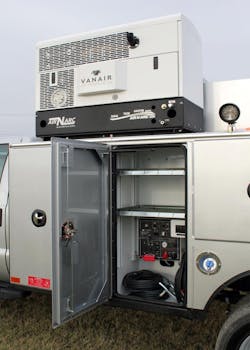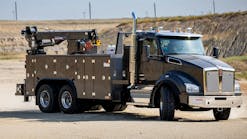Companies that rely on field service as a revenue stream are continually faced with optimizing their investments in field service vehicles. The cost of a unit continues to increase so managers are focused on how to best utilize their investment for optimal performance.
The landscape of field service vehicles is comprised of many types of configurations, from small commercial vehicles that are less than 10,000 pounds GVW up to Class 8 chassis with large service truck packages mounted to them. How the unit is up-fit can have a great impact on how it is utilized in the field. With so many choices, how does a manager decide what to purchase and still have a unit that is utilized efficiently?
Start with understanding service needs. Asking questions about how the unit will be used can assist in deciding how to configure it. What work is expected of the vehicle for the majority of the time it is being used? By answering this question, you can then configure a package to fit the specific requirements in order for the work to be done efficiently.
Efficient use of a service vehicle means, at its simplest form, that the unit allows its intended work to be completed on time by being equipped with the proper tools to accomplish the job at hand. The add-on equipment for a properly configured service vehicle impacts its use by addressing storage, on-board power, lifting, and ancillary needs such as welding. Proper sizing of the options has tremendous impact on unit efficiency by making sure the equipment is sized according to the needs of the service vehicle.
Storage
When considering storage options, one must look at what parts and tools will be needed for the work of the vehicle. Whether the package is configured with shelves, drawer sets, bolt bins, rollout trays, or any other option, consideration of what will be stored impacts what you decide to go with. Careful consideration of your storage needs will allow you to effectively specify proper options to optimize the storage of a service vehicle.
Access to tools and parts impacts productivity by having easy access to whatever is needed to complete a job. The amount of time needed to get a part or tool can be minimized with a well-thought-out layout for the storage options. This allows the operator to spend time on value-added work versus digging through a compartment to find something.
A trend that has entered into the market over the last few years is the use of more aluminum options for parts and tool storage. This has happened as managers have looked at how they can better control the overall unit weights of their vehicles. Overloading a service truck can expose a fleet to noncompliance with DOT regulations and increased service costs due to premature wear on the chassis.
On-board Power
On-board power comes in various forms from air compressors to generators, with most service vehicles requiring air and electricity to perform the various tasks at hand. From pneumatic to electric tools, all are important to complete jobs; how they are specified can impact their usefulness. The efficiency of a service truck is greatly improved with properly specified power source add-ons.
The author, Tim Worman, is the product manager for Vanair Manufacturing. He has almost 30 years of market experience, with roles in engineering, product management, marketing, and business development related to service vehicles.
Air compressors come in various types (reciprocating, rotary screw, etc.), various drive mechanisms (PTO-driven, hydraulically driven, engine-driven, belt-driven, etc.), various mounting (underdeck, underhood, self-contained, etc.), various air delivery (as little as 10 to as much as 300 cfm), and various pressure settings, so choosing the correct one for the application can be daunting. An air-consumption analysis can assist in determining the right size for the application needs.
An air-consumption analysis reviews what the compressor will primarily be used for in its daily use. It will also review the various components in an air system that are needed to support the use of the compressor: remote air tanks, air hose reels, filter/regulator/oiler, nonregulated air and so on. All of these components are factored in to assist in determining compressor type and size.
Once the size of compressor is determined, one must then decide on the type of compressor to produce the required output. The two most common compressor types are reciprocating and rotary screw, with both having advantages and disadvantages over each other.
Reciprocating air compressors are viewed as a staple of the service vehicle market, having been around for quite some time, and are considered to have low maintenance costs over their life. The shortcoming of this type of compressor is their cfm output capabilities in relation to their size. The more cfm required, the bigger and heavier the compressor will become. For a manager, the overall vehicle weight is critical for payload capabilities to support an efficient unit. The more the add-ons weigh, the less payload that is available for parts and tools.
Higher cfm requirements typically lend themselves to the use of the rotary screw type, as their physical size and weight are low compared to an equivalent reciprocating air compressor. There has been a market trend over the past few years to utilize 60 to 80 cfm at 150 psi for air needs. The use of a rotary screw air compressor accomplishes this and is more compact, thereby addressing the payload issue by weighing less. It comes at a price though—potentially higher maintenance costs over its life.
There is a tendency to undersize a compressor to save some money, but this will not allow an operator to effectively complete a job, as he will be using valuable time waiting for the compressor to cycle before there is enough air to complete a task. This increases the amount of time it takes to do a job, which is inefficient use of time. The productivity of the service vehicle is a key component in measuring the efficiency of the unit. By having increased wait time, the productivity drops, along with its efficiency.
Generators are another on-board power source that is critical to the function of a service vehicle. Operators will always have a need for some sort of electrical supply for their tools, rechargeable batteries, auxiliary lighting, etc. The demand for electrical power is greater today than it ever has been on a service truck; where 3,500 kW would have been sufficient in the past, the market has seen that increase to a minimum of 5,000 kW today.
The increase in demand can be attributed to the type of service tools that are carried in a service vehicle today, such as laptops, diagnostic tools, and scanners, to communicate with the equipment being worked on. Also, operators are carrying more battery-operated, hand-held tools that make the completion of jobs much easier and all of which require recharging.
As with air compressors, an undersized generator will impact the efficiency of the service vehicle. By not having enough power to operate the tools needed for the job, a job will either take too long, or an additional power supply will be needed to allow completion of the work. In both scenarios there is a negative impact on the usefulness of the service truck, either underutilization or increased costs for the work to be performed.
Lifting
An age-old question for a service vehicle: How do I address my lifting needs? You must first ask what are the lifting needs, and the answer to this will assist in determining if an add-on piece of equipment is even needed. Why is this so important?
Lifting needs can be addressed with various solutions ranging from load gates to cranes. If the lifting need question is not answered, you could specify a solution on a service truck that will never be used, or underused, at the penalty of added cost and weight. An underutilized option is an inefficient use of dollars and payload, so making sure there is a true need is an important first step.
If your service vehicle has a need for lifting, having the right lifting device will allow for the service truck to be used efficiently. Much like doing an air-usage analysis, you would need to analyze what the lifting needs are for the service vehicle. For light loading into and out of the load space, a load gate is an economic method of doing this. If the service truck is going to be used for field service work that requires the lifting of heavy components, a crane would be the best option to optimize the use of the vehicle.
If the lifting need requires loading cargo in the back of the vehicle, a load gate would be your best option to pursue. This is an efficient way to safely load components in and out of a service vehicle. Load gates come in various deck sizes, storage options (fold up, fold under, etc.), capacities, and materials (steel and aluminum). Aluminum load gates have gained popularity as managers are continually attempting to optimize their payload capabilities.
The load gate will need to be sized according to the heaviest weight to be lifted, to ensure that the load gate can be used each time. The size of the load gate also impacts the drivability of the vehicle, as a load gate that is too large for the chassis will add too much weight behind the rear axle.
Reprinted with the permission of Equipment Manager magazine, the magazine of the Association of Equipment Management Professionals.
A common option on a mechanics service truck is a telescopic crane for lifting larger loads and handling parts during the service job. The selection of a telescopic crane can be just as daunting as selecting an air compressor, as there is are many options to choose from. A telescopic crane varies in drive system (electric or hydraulic), controls (tethered or radio remote), reach (10 to 30+ feet), and capacity (from 2,000 to 14,000 pounds). The configuration of the crane will have great impact on the productivity of the service vehicle, especially if one is configured too small and it cannot perform the needed daily tasks needed by it.
Conversely, a crane that is oversized will negatively impact the efficiency of the service truck. Some would assume that larger is better when it comes to sizing a crane, but a crane that is too large consumes too much payload to justify having it. Reduction of payload decreases the effective use of the service truck, as you reduce your ability to carry parts for the jobs of the day.
Welding
An add-on that can improve the efficiency of a service vehicle is on-board welding capabilities. The welding option on a service truck would be for repair purposes and not necessarily production-type welding. As a manager, you have to determine if the welding need is great enough to justify the purchase of a mobile weld machine.
As with the other equipment referenced here, there are multiple options for welding units in the market that include drive mechanism (engine, PTO shaft drive, hydraulic, etc.), amperage output sizes, and type (stick, wire, etc.). Evaluation of the welder configuration falls under the same reasons as properly sizing a compressor or crane: efficient utilization of the machine. A unit that is undersized will not be able to perform the task of the operator, and one that is oversized comes with a cost and weight penalty.
Multifunction units
The service truck market has seen an increased demand for multifunction add-ons to increase the efficiency of the service vehicle. These units combine air compressors, generators, welders, jump-start capability, and hydraulic systems into one unit to free up load space and reduce payload constraints. By combining all of the add-on components into one, there is increased room for other components on the service body package.
Managers are continually looking to control the life cycle costs of their fleet in any way they can. Maintenance and fuel costs are areas that can be managed more efficiently if the chassis engine is not used to drive the add-on equipment. Self-contained multifunction units allow for the various functions to be operated independent of the chassis engine. Units equipped with a hydraulic circuit can also drive hydraulic cranes, or other hydraulic-driven options, without the chassis as the power supply.
Managers will always be faced with how to efficiently utilize their service vehicles to have an effective return on investment. Careful analysis of how to configure the vehicle with the right add-on options will greatly impact how efficiently a service vehicle is optimized.







